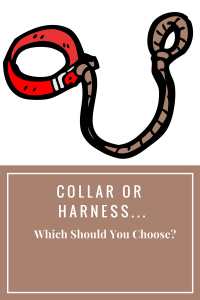Remember…before making the decision to use a harness or collar for walking, always discuss any health issues or special needs with your veterinarian to ensure a healthy exercise regime for your pooch!
“Do you suggest a collar or harness to walk? There are so many choices and D.O.G. pulls!” I have been asked this question many times when consulting with clients whose dogs are lucky enough to be walked by my pet sitting service during their owner’s work day. My answer usually is “It depends!” After all, dogs have different needs based on various factors such as breed, health, temperament and other individual needs. These factors should take utmost priority when deciding if it is best to walk your dog using a collar or harness.
There are distinct differences between using a harness or collar for walking. Both have benefits but both pose challenges as well. Let’s take a look at the pros and cons of both. Hopefully after reading on, you’ll be able to better decide which is better for your dog!
Comparing Dog Harnesses vs. Collars
Using a harness to walk your dog has several benefits. From a health perspective, a harness is a healthier option for dogs that are heavy duty pullers or breeds prone to tracheal issues like pug and toy breeds. Walking dogs that exhibit these characteristics in a flat collar often lead to health problems down the road. Dogs that pull and/or lunge excessively and toy breeds with delicate necks that pull can experience tracheal collapse and whiplash type side effects from prolonged walking on a regular collar. Many dogs have sustained serious neck injury from prolonged pulling over several years. For these reasons, harnesses are often a healthier option as there is no strain or injury to the neck.
From a behavioral perspective, walking your heavy puller or reactive dog using a harness to walk is often a safer and more effective management tool for pulling and dog reactivity, coupled with an effective training regime. Harnesses discourage jumping and pulling, especially the front clip variety. This enables owners to walk strong pullers or reactive dogs more safely. Dogs that lunge are easier to physically manage with a harness as it changes the center of gravity. In my personal experience, dogs that naturally pull seem to pull less when wearing a sturdy, well made harness.
Some dogs will not like the feel of a harness around their middle, but I have found this to be very rare in my own dogs, and the dogs that I pet sit. Front clip harnesses seem to be the most difficult harnesses for some dogs to adjust to. These are typically no-pull harnesses. Slow introductions and consistent feedback in the form of praise as your dog accepts the harness usually overcomes these potential challenges.
Collars are obviously the more traditional approach to managing a dog during a leashed walk. One of the greatest benefits of a collar is that it presents an immediate source of identification if your dog is lost or stolen. If your dog is lost, having a collar with identifying tags will make a big difference in how quickly you are reunited with your dog. More dogs are reunited with their owners from wearing collars than having microchips. After all, if a private citizen or neighborhood business owner finds your wandering pooch, nine times out of ten, they won’t have a microchip scanner! In a nutshell, a good rule of thumb is to always have a collar with identifying tags on your dog, even if you use a harness for walking. When choosing durable collar tags, it’s important that they stand the test of time. Boomerang Tags offer high quality, durable pet tags in a variety of materials that don’t fade or rub over time. My oldest dog, Miss Vicki, is almost 15 years old and has the same Boomerang tag that I got her when she was six months. It is just as crisp and clear as when I first got it!
If your dog is not a heavy puller and there is minimal strain to the neck walking with a collar may be a viable option for walking your dog if that is what you are comfortable with. Also, if you dog does not have any tracheal or respiratory issues, wearing a collar shouldn’t be an issue to use for walking. 
Whether you choose to walk your dog using a harness or collar, always practice ‘check-in’s’ with your dog so that they always default to you for direction in iffy situations. ‘Watch’, ‘Look at the Dog’ and ‘On By’ are some fun games to teach to re-direct the intense pooch from straining on the leash with a little too much exuberance!
Do you prefer walking your dog with a collar or harness? Why? Let us know in the comments!


 Cindy Tesler says
Cindy Tesler says
November 11, 2016 at 6:11 pmI agree that you should discuss training issues about your pet with your veterinarian. You go on to talk about how a harness is great for breeds that are prone to tracheal issues. I think it’s important to choose a training harness that is also adjustable so that it can “grow” with your pet.
 Feed fond says
Feed fond says
April 10, 2018 at 10:32 amHi, Millicent Little
Great blog. I found your blog very useful and it is very well-written. After going through your blog, I’ll able to better decide which is better for a dog. I think using a harness for dogs while walking has several benefits. A harness is the healthiest option for dogs, although not every breed is comfortable with a harness. Moreover, a harness causes no strain or no injury to a dog’s neck. When safety is a concern, collars present an immediate source of identification if a dog is lost or stolen. Thanks for your valuable post.
 Mirage Pet Products says
Mirage Pet Products says
February 1, 2019 at 2:02 pmHey, Is this your dog? He/she looks so beautiful. B.t.w thanks for writing a unique article.
 Robert Marshall says
Robert Marshall says
November 23, 2020 at 10:35 amThank you for this article because it’s really informative, I love reading your article. It is very helpful for me and everyone who want to know about how choose harness vs collar.
dog leash